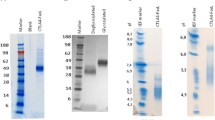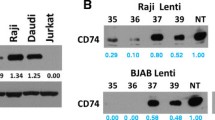Abstract
We found that a short synthetic peptide corresponding to the “antisense homology box” of Fas ligand induced apoptotic cell death of Fas-expressing human ovarian cancer cell lines. The peptide was deduced from residues 256–265 of human Fas ligand, based on the hypothesis that it should contain a specific binding site to the corresponding Fas. Interestingly, the ovarian cancer cell line NOS4, which was sensitive to anti-Fas antibody induced apoptosis, was not affected by the peptide, whereas another cell line, SKOV-3, which was insensitive to anti-Fas antibody, was killed by the peptide. Thus, this short peptide was shown to have a unique activity to induce apoptosis in human ovarian cancer cells in a manner different from anti-Fas antibody.
Similar content being viewed by others
References
Owen-Schaub LB, Yonehara S, Crump W, Grimm EA. DNA fragmentation and cell death is selectively triggered in activated human lymphocytes by Fas antigen engagement. Cell Immunol 1992; 140: 197–205.
Miyawaki T, Yonehara S, Taniguchi N, et al. Differential expression of apoptosis-related Fas antigen on lymphocyte subpopulations in human peripheral blood. J Immunol 1992; 149: 3753–3758.
Wakahara Y, Wakahara F, Tomoda Y, et al. Combination effect of anti-Fas antibody and chemotherapeutic drugs in ovarian cancer cells in vitro. Oncology 1997; 54: 48–54.
Hayakawa A, Yokoyama I, Tajiri H, Okamoto T, Nakashima I. Protein kinase C-dependent anti apoptotic mechanism that is associated with high sensitivity to anti-Fas antibody in ovarian cancer cell lines. Cancer Letters 1999; 140: 113–119.
Enari M, Hug H, Nagata S. Involvement of ICE like protease in Fas-mediated apoptosis. Nature 1995; 375: 78–81.
Sato T, Irie S, Kitada S, Read JC. FAP-1: A protein tyrosine phosphatase that associates with Fas. Science 1995; 268: 411–415.
Suda T, Takahashi T, Goldstein P, Nagata S. Molecular cloning and expression of the Fas ligand, a novel member of the tumor necrosis factor family. Cell 1993; 75: 1169–1178.
Schneider P, Bodmer JL, Tschopp J, et al. Characterization of Fas (Apo-1, CD95)-Fas ligand interaction. J Biol Chem. 1997; 272: 18827–18833.
Starling GC, Bajorath J, Kiener PA, et al. Identification of amino acid residues important for ligand binding to Fas. J Exp Med 1997; 185: 1487–1492.
Fadeel B, Lindberg J, Achour A, Chodi F. A three-dimensional model of the Fas/Apo-1 molecule: cross-reactivity of anti-Fas antibodies explained by structural mimicry of antigenic sites. Interna Immunol 1998; 10: 131–140.
Bost KL, Smith EM, Blalock JE. Similarity between the corticotropin (ACTH) receptor and a peptide encoded by an RNA that is complementary to ACTH mRNA. Proc Natl Acad Sci USA 1985; 82: 1372–1375.
Baranyi L, Cambell W, Okada H, et al. The antisense homology box; a new motif within proteins that encodes biologically active peptides. Nature Med 1995; 9: 894–901
Takei M, Kojima T, Del Carpio CA. Analysis of sense and antisense peptide relationship in immunoglobulin IgE. In: Peptide Chemistry. Osaka, Japan: Protein Research Foundation, 1996: 217–220.
Blalock JE, Smith EM. Hydropathic anti-complementarity of amino acids based on the genetic code. Biochem Biophys Res Commum 1984; 121: 203–207.
Blalock JE. Complementarity of peptides specified by 'sense' and 'antisense' strands of DNA. Trends Biotech 1991; 6: 140–144.
Gorcs JJ, Gottschall PE, Coy DH, Arimira A. Possible recognition of the GnRH receptor by an antiserum against a peptide encoded by nucleotide sequence complementary to mRNA of a GnRH precursor peptide. Peptides 1986; 7: 1137–1145.
Knutson VP. Insulin-binding peptide: design and characterization. J Biol Chem 1988; 263: 14146–14151.
Moore GJ, Ganter RC, Flanklin KJ. Angiotensin "antisensepeptides": (¡) messengerRNAcomplementary to human angiotensin II (+) messenger RNA encodes an angiotensin receptor antagonist. Biochem Biophys Res Commum 1989; 160: 1387–1391.
Kang CY, Brunk TK, Blalock JE, Kohler H. Inhibition of self-binding antibodies (autoantibodies) by a VH-derived peptide. Science 1988; 240: 1034–1036.
Pasqualini R, Chamone DF, Brentani RR. Determination of the putative binding sites for fibronectin on plateletglycoprotein IIb-IIIa complex through a hydropathic complementarity approach. J Biol Chem 1989; 264: 14566–14570.
Ghiso J, Saball E, Leoni J, Rostagno A, Frangione B. Binding of cystatin C to C4: the importance of sense-antisense peptides in their interaction. Proc Natl Acad Sci USA 1990; 87: 1288–1291.
Ruiz-Opazo N, Akimoto K, Herrera VLM. Identification of a novel dual angiotensin II/vasopressin receptor on the basis of molecular recognition theory. Nature Med 1995; 10: 1074–1081.
Eberle AN, Huber MJ. Antisense peptides: Tools for receptor isolation? Lack of antisense MSH and ACTH to interact with their sense peptides and induce receptor-specific antibodies. Receptor Res 1991; 11: 13–43.
Rasmussen UB, Hesch RD. On antisense peptides: the parathyroid hormone as an experimental example and a critical theoretical view. Biochem Biophys Res Commun 1987; 149: 930–938.
Root-Bernstein, RB. Amino acid pairing. J Theor Biol 1982; 94: 885–894.
Author information
Authors and Affiliations
Rights and permissions
About this article
Cite this article
Hayakawa, A., Kojima, T., Yokoyama, I. et al. A short peptide derived from the antisense homology box of Fas ligand induces apoptosis in anti-Fas antibody-insensitive human ovarian cancer cells. Apoptosis 5, 37–41 (2000). https://doi.org/10.1023/A:1009633525205
Issue Date:
DOI: https://doi.org/10.1023/A:1009633525205




